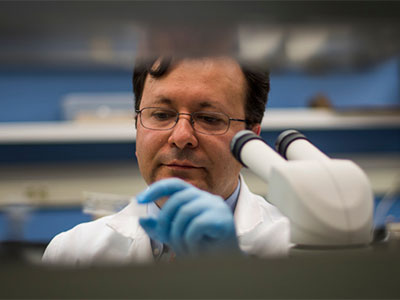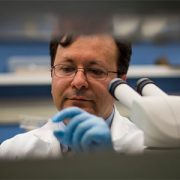
“The plasticity of the developing brain does make it susceptible to treatments that alter its pathways,” says Joseph Scafidi, D. O., M.S. “Thankfully, that same plasticity means we have an opportunity to mitigate the damage from necessary and lifesaving treatments by providing the right support after the treatment is over.”
One of the latest developments in oncology treatments is the advancement of molecularly targeted therapeutic agents. These drugs can be used to specifically target and impact the signaling pathways that encourage tumor growth, and are also becoming a common go to for ophthalmologists to treat retinopathy of prematurity in neonates.
But in the developing brain of a child or adolescent, these pathways are also crucial to the growth and development of the brain and central nervous system.
“These drugs have been tested in vitro, or in tumor cells, or even in adult studies for efficacy, but there was no data on what happens when these pathways are inhibited during periods when their activation is also playing a key role in the development of cognitive and behavioral skills, as is the case in a growing child,” says Joseph Scafidi, D. O., M.S., a neuroscientist and pediatric neurologist who specializes in neonatology at Children’s National Health System.
As it turns out, when the drugs successfully inhibit tumor growth by suppressing receptors, they can also significantly impact the function of immature brains, specifically changing cognitive and behavioral functions that are associated with white matter and hippocampal development.
The results appeared in Cancer Research, and are the first to demonstrate the vulnerability of the developing brain when this class of drugs is administered. The pre-clinical study looked at the unique impacts of drugs including gefitinib (Iressa), sunitib malate (Sutent) and rapamycin (Sirolimus) that target specific pathways responsible for the rapid growth and development that occurs throughout childhood.
The agents alter signaling pathways in the developing brain, including decreasing the number of oligodendrocytes, which alters white matter growth. Additionally, the agents also impact the function of specific cells within the hippocampus related to learning and memory. When younger preclinical subjects were treated, impacts of exposure were more significant. Tests on the youngest pre-clinical subjects showed significantly diminished capacity to complete cognitive and behavioral tasks and somewhat older, e.g. adolescent, subjects showed somewhat fewer deficits. Adult subjects saw little or no deficit.
“The impacts on cognitive and behavioral function for the developing brain, though significant, are still less detrimental than the widespread impacts of chemotherapy on that young brain,” Dr. Scafidi notes. “Pediatric oncologists, neuro-oncologists and ophthalmologists should be aware of the potential impacts of using these molecularly targeted drugs in children, but should still consider them as a treatment option when necessary.”
The effects are reversible
Researchers also found measurable improvements in these impaired cognitive and behavioral functions when rehabilitation strategies such as environmental stimulation, cognitive therapy and physical activity were applied after drug exposure.
“The plasticity of the developing brain does make it susceptible to treatments that alter its pathways,” says Dr. Scafidi. “Thankfully, that same plasticity means we have an opportunity to mitigate the damage from necessary and lifesaving treatments by providing the right support after the treatment is over.”
Many major pediatric oncology centers, including the Center for Cancer and Blood Disorders at Children’s National, already incorporate rehabilitation strategies such as cognitive therapy and increased physical activity to help pediatric patients return to normal life following treatment. The results from this study suggest that these activities after treatment for pediatric brain tumors may play a vital role in improving recovery of brain cognitive and behavioral function in the pediatric population.
This research was funded by grants to Dr. Scafidi from the National Brain Tumor Society, Childhood Brain Tumor Foundation and the National Institutes of Health.






